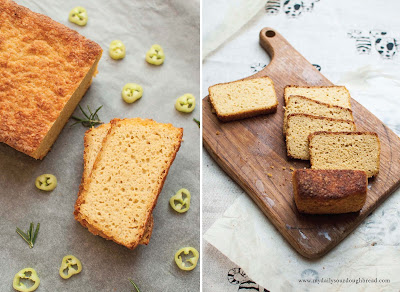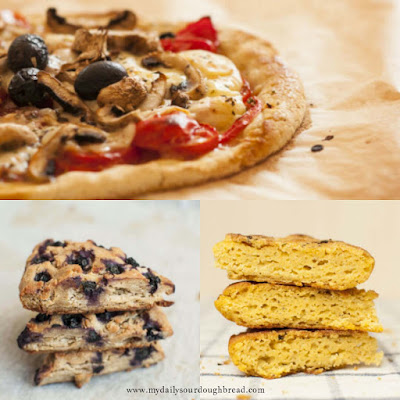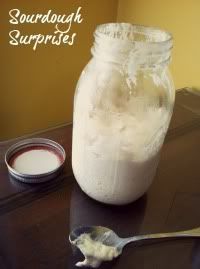We have a super special treat for you today! Several of you have asked for knowledge about Gluten Free Sourdough Baking. I don't a thing about gluten free, so I asked the amazing Natasa if she would mind preparing some info for you. The following is a guest post written by her, and it is so detailed and interesting! I know you will enjoy it!
Natasa Djuric is the real sourdough baking specialist and the author of My Daily Sourdough Bread blog (www.mydailysourdoughbread.com) where she shares her knowledge on how to bake delicious and great-looking sourdough breads and other sourdough goods at home. She is also the author of the online step-by-step sourdough baking master class Instantly Experience the Power of Real Sourdough Baking (www.learnsourdoughbread.com) which includes more than 25 diverse both gluten and gluten-free sourdough recipes and enhances your baking skills and health to another level.
Taste for
sourdough is growing worldwide and that is easy to understand. Crusty loaf,
made in honoured way using and harnessing the raising power of wild yeasts and
bacteria. Real sourdough baking is an object of craft, beauty and nourishing. Its
characteristics and flavour is vastly superior. It's no surprise that more and
more people are learning this ancient skill.
Just like
sourdough baking, gluten-free baking in general has gained a lot of attention in
the last years. Many people suffer from hidden gluten sensitivities and to
uncover this for yourself you need to go gluten-free for at least few weeks and
monitor your body and well-being.
Bread is
a major part of the modern diet. It’s a staple in our everyday lives and many
people are eating some type of bread with most of their meals. Going gluten-free
and eating no bread can be nightmare for some people, because there are no
decent alternatives to gluten breads and gluten-free baking is quite a
challenge. Let's explore this further.
Gluten is
a protein found in flours like wheat, barley, rye, oat, spelt, einkorn, and Khorasan
wheat. It is very important in the bread making process. When flour is mixed
with water, the gluten swells to form a continuous network of fine strands.
This network forms the structure of bread dough and makes it elastic and
extensible.
In
gluten-free baking we are baking with gluten-free flours and we need to figure
out new ways that replace the gluten.
Commercially
available gluten-free breads are often risen quickly and contain ingredients
which don’t nourish our bodies and mind on the long run: xanthan/guar gum, commercial
yeast, baking powder, sugar or other artificial sweeteners, fruit juices, eggs
of unknown source, artificial vitamins, minerals, folic acid and B vitamins,
soy and large amounts of high-starch flours.
I like to
keep things simple, easy and natural, regarding both the ingredients and the
processes. And for me natural process refers to sourdough fermentation.
Sourdough or lactic acid
fermentation can enrich bodies in many ways. Lactic acid produced during the sourdough fermentation has
the ability to lower the insulin responses, assisting you to maintain healthy
weight and prevent cravings, as well ensuring your blood glucose level remains in line, helping you to guard
against various diseases especially diabetes. Fermentation improves the overall nutritional
profile of your flour and with this you can gain maximum nutritional benefits
from your baked goods.
Besides
baking without gluten, gluten-free sourdough baking means baking leaving out rising
agents like commercial yeast that rise the dough very fast and no lactic acid
fermentation can take place.
However, this
doesn’t mean gluten-free sourdough baking is difficult, it is just different
and often less complicated than gluten sourdough baking as we simply mix all
the ingredients and let the dough ferment. Once we understand the behaviour of gluten-free
sourdough, options for baked goods are limitless. We can bake pizzas, pies,
scones, focaccias, pancakes, crackers, biscuits, etc.
 |
| Grain Free Millet Sourdough Bread |
First,
let’s look at what kind of flours
can be used in gluten-free sourdough baking:
-
Buckwheat flour*
-
Quinoa flour
-
Millet flour
-
Brown and white rice flour
-
Corn flour
-
Amaranth flour
-
Sorghum flour
-
Teff flour
-
Oat flour**
Not all
of them are available everywhere. The best option to keep gluten-free baking at
low cost is to buy flours from grains that are local to where you live or are
easily available and inexpensive and also to mill your own flours at home.
Grinding flours at home keeps the nutritional value of your flour at the
maximum level and it also enables you to prepare the grains prior to milling,
like soaking or sprouting them.
Each of these flours behaves differently in the terms of water
absorbency and the effect on the final crust and crumb result, so it’s better
to start with less water and to gradually add more water later when you see how
much water your flour can handle.
*If you are gluten sensitive and want to use buckwheat make sure that
it's certified gluten-free, since it's very often cross-contaminated due to
being processed in facilities in which also gluten grains are handled.
**Oats contain avenin which is an equivalent of gluten in wheat. It has
been intensively debated in the last years whether oats are safe for celiacs. It’s
up to a personal choice to decide whether to include it in your gluten-free
diet or not. Just like buckwheat, oat is often cross-contaminated with other
gluten containing grains.
Binders are
optional but often preferred adding in gluten-free sourdough baking. Their
function is to bind moisture and help make breads and other baked goods less
crumbly. This ability to hold the water is called hygroscopy and you will
notice this if you soak husks or seeds into water – the mixture will turn into
a gluey and thick substance. What is more, binders listed below are all
beneficial to our bodies in general. They represent a good source of dietary
fibre and help to improve and maintain regular gastrointestinal transit.
Common types of binders I use are:
-
Psyllium husk and psyllium husk powder
-
Whole chia seeds or ground chia seeds
-
Golden and dark whole flaxseeds or
ground flaxseeds
Sometimes you may add other ingredients to discover and create new
flavours and textures, like:
-
(Roasted) seeds and nuts (sunflower,
sesame, hemp, and pumpkin seeds, walnuts, pecans, hazelnuts)
-
Fats (butter, ghee, coconut oil, olive
oil)
-
Dairy products (milk kefir, yogurt)
-
Flakes (millet, buckwheat, quinoa or
rice flakes)
Equipment
for gluten-free sourdough baking:
-
Baking tin for proofing and baking breads
-
Baking stone or baking tray for baking pizzas,
scones, etc.
-
Grain mill to mill your own flour
(buying grains instead of flour is usually much cheaper)
Gluten-free sourdough starter
The basis
for gluten-free sourdough baking is a vibrant, stable and active gluten-free
sourdough starter. Just like creating gluten sourdough starter, the process is
the same for gluten-free starter. It usually takes 3 days to build your
gluten-free starter from scratch. All you have to do is to mix flour with
water, let it sit at the warm place for 24 hours or until active, feed it for
the first time, let it ferment for another 24 hours and then feed it again. I
advise you to use freshly milled flour since they ferment faster than
store-bought flours.
General
tips for gluten-free sourdough baking
-
don’t compare with gluten baking
-
be patient, practise makes perfect
-
get to know the flour you are using and
adjust the process
There is flood of recipes on the internet for gluten-free breads. The
huge problem with most recipes for gluten-free breads out there is that they
are either calling for hard to get flours or highly processed gluten-free
flours which as well are full of starches, synthetic vitamins, minerals and
binders. More, the end result is often dense, crumbly, expensive bread without
texture, taste, structure or crispy crust. In other words, I didn't come across
gluten-free bread that is simple, good for digestion, natural and easy to make.
So one day, I challenged my boyfriend and myself who will first make
decent gluten-free sourdough bread. After some trial and error he came out with
amazing gluten-free bread and it turned out that sourdough fermentation worked
best and gave best results. The end results were bread, a process and a recipe
that you can make at home without complicated ingredients.
It’s gluten-free bread that is soft and airy, yet moist and flexible. It
has crispy crust, tastes great, its' gluten, egg, soy, gum and dairy free,
cheap, simple & quick to make, it cuts without crumbling and falling apart.
You can bend it a good amount without breaking and it holds together well. At
the same time you can enjoy benefits of sourdough fermentation.
And it's just glorious for sandwiches too.
This process and recipe are really a breakthrough in gluten-free baking.
For the first time, gluten sensitive or people with allergies can have great
bread back into their diets without suffering the consequences of gluten or
other allergens in their system. It's also very welcome for people that like
taking care for their bodies.
I prepared special video and downloadable pdf tutorial to show exactly how
to make gluten-free sourdough bread and gluten-free sourdough starter and you
can check it here (http://www.mydailysourdoughbread.com/video-tutorial-how-to-make-amazing-simple-gluten-free-sourdough-bread-secret-process-revealed/).
Happy gluten-free sourdough baking!
About
Natasa Djuric










7 comments:
I have read your excellent post. This is a great job. I have enjoyed reading your post first time. I want to say thanks for this post. Thank you...
ghee nutritional benefits
I must admit that your post is really interesting. I have spent a lot of my spare time reading your content. Thank you a lot!
benefits of eating ghee
Hi there i amm kavin, its my first occasion to commenting anywhere,
when i read this paragraph i thought i could also
create comment due to this sensible post. 오피사이트
Admiring the time and effort you put into your blog and detailed information you offer!..
토토
안전놀이터
You did cheerfully empower me because of the ideas you have posted.
토토사이트
먹튀검증
What an amazing article. Genuinely love it, thank you! I really adore your blog.
바카라사이트
카지노
thank you for such a wonderful article I liked it very much I was interested in reading it and now I advise everyone to read it! if you read something that just is
카지노사이트
홈카지노
Post a Comment